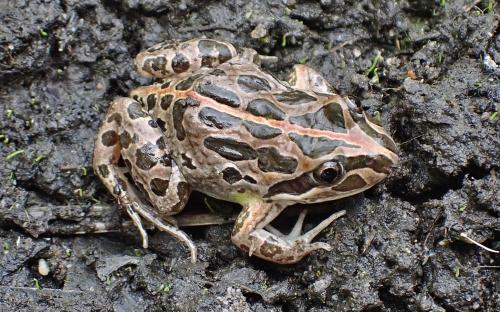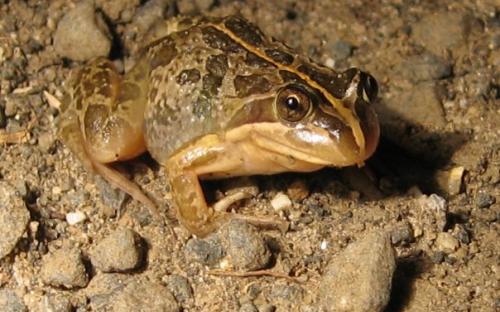Conservation status: least concern
What do they look like?
A medium sized frog that can grow up to 5cm. They have a grey-brown or olive-green back with dark green or brown patches and a white underbelly. They often also have a cream or red coloured stripe running across the middle of their back and a cream coloured stripe running from under the eye to the top of the arm. Males have a yellow throat during mating season. The pupil is nearly round and the iris is gold.
What to listen out for
Single sharp sounds described as a ‘click’ or ‘plock’. They are most commonly heard calling from September to December, but can be heard throughout the year if there has been enough heavy rainfall or flooding.
LISTEN:
https://www.facebook.com/watch/?v=727841654436291
https://www.youtube.com/watch?v=uEBrrc9STss
https://www.youtube.com/watch?v=qzecKSLQEvE
Where to find them
The Spotted Marsh Frog lives in dams, ponds, marshes, flooded grasslands and even deep puddles on the side of roads, and are found around the coast of New South Wales and Queensland, the southeast of South Australia, most of Tasmania, and all of Victoria. They can even survive in the dry interior of Australia.
You can spot them in Bayside at the Tulip Street Pond (near the Sandringham Leisure Centre), Pobblebonk Park (George St, Sandringham) and Yalukit Willam Nature Reserve (Elsternwick). Listen for their calls in Spring and
Autumn, or after heavy rainfall.
Life Cycle
Typically breeds during Spring and Autumn, but can also breed in Winter if there is enough heavy rainfall. Females can lay up to 1,500 eggs as a foamy mass on the surface of dams, ponds or puddles, tucked under plants to protect them from predators. The eggs are tiny at only 1mm in size. Living at the bottom of water bodies, the tadpoles may grow up to 7cm long before becoming frogs 3 to 5 months after hatching. Tadpole colour ranges from light to dark gold-brown or a translucent gold.
Did you know?
• The Spotted Marsh Frog is sometimes also called the Spotted Grass Frog.
• Female Spotted Marsh Frogs in South Australia seem unable to create foam in which to lay their eggs; instead they lay them in small foamless clumps.
• Spotted Marsh Frogs are mostly active at night. They are ground dwelling and during the day will remain hidden beneath logs or rocks around water sources.
Download our factsheet
FoNW Factsheet - Spotted Marsh Frog
References and Further Reading
https://www.frogid.net.au/frogs/limnodynastes-tasmaniensis
https://backyardbuddies.org.au/backyard-buddies/spotted-grass-frog/
https://australian.museum/learn/animals/frogs/spotted-marsh-frog/
Credits
Author: Nykita Ivanoff
Photos: John Eichler, Christina Renowden




